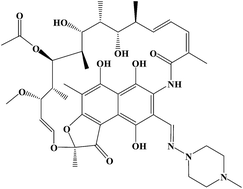Efficient one-pot synthesis of carbon dots as a fluorescent probe for the selective and sensitive detection of rifampicin based on the inner filter effect
Abstract
In this paper, carbon dots (CDs) emitting blue fluorescence were prepared using ammonium citrate and ammonium thiocyanate through a low-cost hydrothermal approach. The synthesized carbon dots with maximum excitation and emission wavelengths at 350 nm and 443 nm, respectively, displayed excitation-independent photoluminescence behavior. The relative quantum yield of the as-prepared carbon dots was measured to be 14%. Importantly, a novel method was designed for rifampicin detection as the fluorescence intensity of carbon dots could be quenched significantly by rifampicin on the basis of the inner filter quenching effect. Under optimal experimental conditions, a satisfactory linear response relation was observed between the fluorescence quenching intensity of the carbon dots and the concentration of rifampicin in the range from 0.43 to 49.0 mg L−1; moreover, the detection limit for rifampicin was as low as 0.13 mg L−1. Therefore, a new method has been successfully established, and it is capable of quantification of rifampicin in real samples.



 Please wait while we load your content...
Please wait while we load your content...